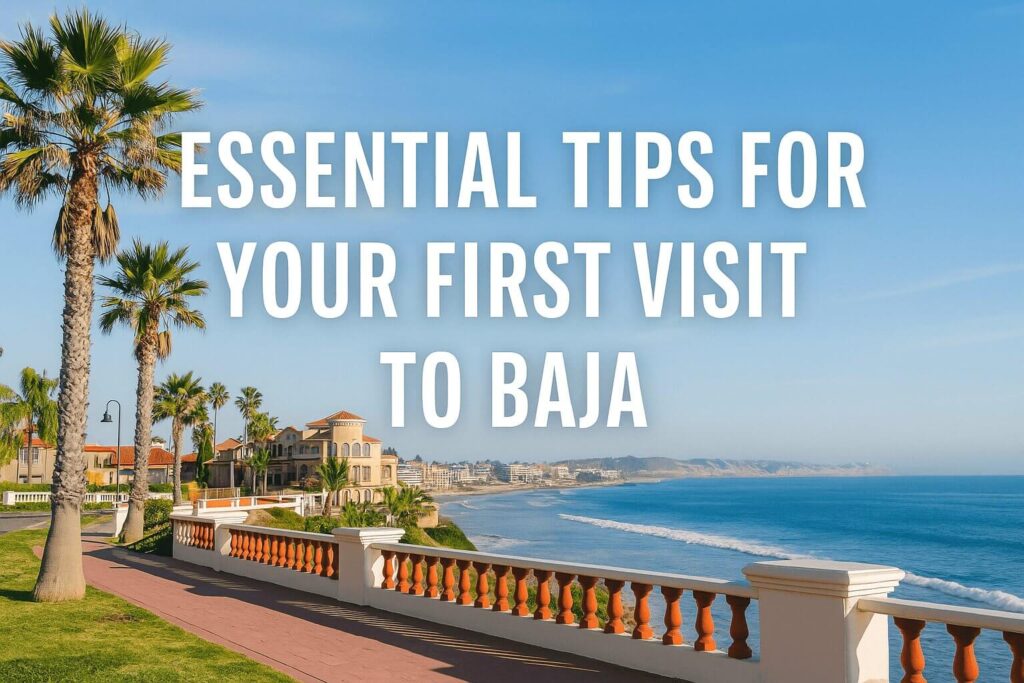
Visiting Baja for the first time:
Here is some useful information to keep in mind when you visit Baja:
Is a passport or visa needed to visit Baja?
If you are crossing by land you can do so with either a U.S. passport book, a passport card, or a SENTRI/Global Entry card, so be prepared to show any of these documents as you cross to and from Mexico.
Many people visit Mexico and travel back by using other official forms of ID, such as a birth certificate, driver’s license, etc. However, if you are asked for your passport and you present your birth certificate or driver’s license, these are not considered “WHTI” compliant and it is entirely up to the border agents if they wave you through, or if they ask additional questions to determine if you are telling the truth. To avoid any of these inconveniences or delays, it is best to bring any of the documents mentioned before.
What is the FMM?
FMM stands for Forma Migratoria Multiple, also known as a Mexico tourist card. It is the document issued by the immigration authority (Instituto Nacional de Migracion) that certifies that your stay in Mexico is legal. You can get your FMM when crossing the border by land, at the declaraciones area, or you can also request it online On the INM website.
Keep in mind that when driving across the border, authorities do not enforce getting an FMM, but it is still a legal requirement. If you are planning on purchasing a property in Baja, this document will be required for you to be legally able to sign any official documents in Mexico, such as a private purchase contract, or at Notaria.
Do I need insurance to visit Baja?
Yes – Mexican authorities require all vehicles traveling on federal roads, bridges, and airports to hold at least a liability coverage policy, and it must be issued by a Mexican insurance carrier. This means that U.S., Canadian, or any foreign insurance policy is not considered “proof of financial liability” under Mexican law.
You’ll need a special Mexican auto insurance policy to legally drive in Mexico, which can be acquired through an insurance agent. You can contact an insurance company to purchase coverage for your trip, and the coverage can span from a one-day coverage to a full year, depending on how often you are planning to visit.
Cellphone coverage and making calls in Baja
Most U.S. cell phone carriers will offer international coverage – if your current plan does not include international roaming, most carriers will let you upgrade your plan for an additional monthly fee. Even if your current plan covers calls and data in Baja, make sure that your phone has been activated for international roaming. You can do this by calling your wireless carrier, checking your current plan, and asking for instructions on how to activate roaming. Keep in mind that some carriers might also charge a fee for calls and texts, so make sure you get all the information from your carrier to avoid any surprises with your bill.
To make calls from your cellphone while in Baja, you must first dial the symbol “+” followed by the country code (with most cellphones, pressing and holding the “0” key will convert it to the “+” key), then the area code of the number you are calling, and lastly the next digits of the phone number: +1 is the code of the U.S., and +52 is the code for Mexico.
So for example, if you are trying to call a U.S. number, it would be the following:
+ 1 (619) 123-4567
Dialing a Mexican number would look like this:
+52 (661) 123-4567
Bringing your pet:
Have you ever felt remorse when you go on a road trip to Baja and leave your beloved pet behind? Well, why not bring your furry companion with you next time? If your only roadblock is information, here’s what you need to know.
These are the requirements for the introduction of cats and dogs to Mexico according to the Secretary of Foreign Relations:
- A Health Certificate issued by an official authority or by a licensed veterinarian provided that his signature is approved by a State Veterinarian. It must be printed on the veterinary clinic’s letterhead, and contain the license number of the certifying veterinarian as proof of that veterinarian’s right to exercise his/her profession. The health certificate must contain the following information:
- Name and address of the owner/exporter (in the country of origin) and if applicable of the importer (address of destination in Mexico).
- Date of application of the vaccine against rabies and its validity – it must be administered at least 15 days before you get to Mexico. (animals under 3 months of age are exempt).
- Certify that in the pre-trip inspection, the animal or animals were clinically healthy.
- That the animal or animals have been internally and externally dewormed, within the previous six months and are free of ectoparasites.
- If you do not comply with the above, you must contact a Veterinarian (of your choice and by your account in Mexico), who will issue the health certificate and apply the corresponding treatment.
For more detailed information you can visit the Mexican Department of Agriculture website about traveling with pets. Especially if your trip will take you further south of Ensenada or to mainland Mexico.
Some general recommendations when traveling with your pets:
- During your visit keep the rabies certificate close at hand.
- If your dog /cat has special dietary needs, bring enough food and water for the duration of the trip, you may not be able to find the brand of pet food your pet needs or prefers. Make sure the pet food you are bringing is packaged and labeled in English or Spanish.
- Make sure your pet has their tag with all your current contact information, if possible put down a local number, your hotel number for example.
- As always never leave your pet unattended in a car.
- Bring any medicines your pet may require.
Security
Often when talking to people about the possibility of purchasing real estate in Mexico the issue of crime enters the conversation. It’s important to note that most of the violence has been situated in Juarez along the US border with Arizona and Texas. The crime rate in Baja is relatively low and has been declining in recent years. Over 2 million U.S. citizens and corporations have invested billions in the Baja Peninsula alone.
Since 2017, with the goal of having one easy-to-remember emergency number, and to reduce waiting times, all emergency calls in Mexico were changed to 911. This also works if calling from an American cellphone. With this number, you will be connected to Mexico’s Emergency Assistance Service, where you can request the following services:
- Cruz Roja – Red Cross /ambulance service
- Bomberos – Firefighters
- Policía municipal – Municipal police
- Protección civil – Civil defense
- National Emergency System
